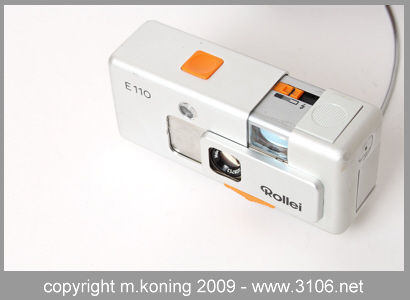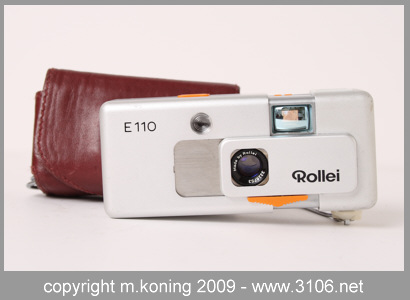3106.photography
Created 25 May 2009 ... Updated 25 May 2009
|
Rollei E 110
|
|||||||||||||||||||||||||||||||||||||||||||||||||||||||||||||||||||||||||||||||||||||||||||
 The aluminium Rollei E 100 was produced in Braunschweig Germany by Rollei from 1974 to 1978. It was an all-automatic camera for the 110 pocket film cartridge, producing 12x17mm negatives. The lens is quite sharp, which was actually a necessity to get good pictures out of the tiny negative.
The aluminium Rollei E 100 was produced in Braunschweig Germany by Rollei from 1974 to 1978. It was an all-automatic camera for the 110 pocket film cartridge, producing 12x17mm negatives. The lens is quite sharp, which was actually a necessity to get good pictures out of the tiny negative.
Its successor was the black, plastic Rollei A 110 was produced in Singapore introduced in 1978 and had a little faster maximum shutter speed of 1/400 sec but all other parameters were equal. Taking pictures with the camera is easy: open the camera, load the cartridge, close the camera, shoot a few blank frames by pressing the shutter button and winding the film by closing the camera (pressing both left and right sides inwards then pulling them outwards again) and you're ready to take pictures. The camera is very small, which also made the viewfinder a little hard to use but for the occasional snap shots the camera is hard to beat, it's tiny so you can take it with you whereever you go. 110 Pocket film was introduced by Kodak in 1972 for use in their new Kodak Pocket Instamatic cameras. The 110 film cartride had a very similar style as the successful 126 film format which was introduced in 1963. The 126 format was for use in the Kodak Instamatic cameras, the 110 format in the Pocket Instamatics. A little confusing. The film format is 13x17 millimeters but the film gate in cameras often measured 12x17 or even 12x16 millimeters. Being a miniture version of the 126 cartridge, the film also had backing paper and did not have to be rewound after being finished. Film loading was easy: open the camera (the hardest part was to find out how to open it), put the cartridge in, close the cameras and shoot a few blanks in order to wind the film to the first negative. When a 35mm negative (measurung 24x36 mm) is enlarged for a standard 10x15cm print the enlargement factor is approximately 4. the enlargement factor for a 110 film negative is 8, which means a huge loss of quality compared to the 35mm format. Even though the small new cameras, with the easy film loading were quite cool, the picture quality was not very high so the 110 film format, although instantly popular and pushing other miniature formats such a used in the Minolta 16 and Minox "spy" camera series from the market but it did not stay popular for long. The marketshare of 110 cameras sold during 1977 was about 40% and also included expensive SLR cameras. As soon as the novelty wore off, people started moving back towards small 35mm cameras using the "old" 135 film format (35mm film) and forgot about their 110 cameras. Most manufacturers have stopped producing 110 film but Kodak film is still available in some supermarkets, although often (nearly) outdated. This film format is also not a standard format that many people are using so you might also have trouble getting it developed. |
|||||||||||||||||||||||||||||||||||||||||||||||||||||||||||||||||||||||||||||||||||||||||||
Specifications
|
|||||||||||||||||||||||||||||||||||||||||||||||||||||||||||||||||||||||||||||||||||||||||||

|
|||||||||||||||||||||||||||||||||||||||||||||||||||||||||||||||||||||||||||||||||||||||||||
|
|||||||||||||||||||||||||||||||||||||||||||||||||||||||||||||||||||||||||||||||||||||||||||
All photos copyright of M. Koning 1997 - 2009
Note: Using the text or images on this site in an auction such as eBay without permission is a violation of your ebay Terms of Service. I will report you to ebay if I discover such a violation taking place. This may result in your account being cancelled. I also reserve the right to file claim for civil penalties.
Return